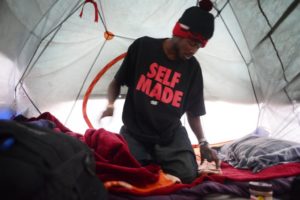The rain fell hard that day. The tent he’d pitched in Howarth Park had leaked and Gerri Jackson’s bed of piled blankets was wet. His Santa Rosa Junior College math textbook was damp.
And he’d just gotten word from a campmate that someone was going to kick them out in 10 days.
“Where’m I gonna go, go, go, bro — I don’t know, I never know,” he said.
The 22-year-old’s singsong voice was just another sound in the night on a muddy hillside tangled with brush and trees, where Gerri was living with the skunks and deer.
It was better than the pavement outside Chop’s Teen Center, where he’d been sleeping days before.
“Concrete sucks the life out of you,” said Gerri, a Chicago native homeless on the streets of Santa Rosa since early 2011.
Adrift and often unknown amid the plenty of Sonoma County, homeless young people reel from abandonment or rejection, flee abuse or broken homes, exit the foster care system unmoored at 18.
They wander, their conditions anonymous, through shopping malls, parks and city centers, ride buses, scrounge free food, cigarettes and, often, drugs. They search for the next safe place to sleep.
Gerri is one of more than a thousand young people under age 24 who are the fastest growing segment of the county’s estimated 4,280 homeless residents. This year’s count revealed 277 teens between the ages 12 and 17 who have nowhere to live — a 200 percent increase in four years.
“They are terrifying statistics,” said Georgia Berland, executive officer of the Sonoma County Task Force on the Homeless.
“What does it mean to their stability, to their ability to engage in society, to be productive?” she said. “If kids are going to be growing up feeling that their community doesn’t even care enough for them to have a roof over their head, that means they’re not going to feel connected to their community. That doesn’t bode well for us.”
More housing, education, job training and employment options, and counseling services are crucial to reversing the situation, Berland said.
“We have to find some way to reconnect with these kids and find a way to help them feel valuable and cared for,” she said. “That is the most important thing we can do.”
TANGLED LIVES
The young people who come to live on Sonoma’s streets have had tangled lives and tell their stories mostly in tangents.

Gerri was in Chicago’s foster care system from age 5 or 6 until 18. He joined the Paragon Marketing Group, which recruits young people as salespeople, as a way to start a new life, and sold subscriptions across the country. He can still recite the sales pitch.
“I learned so much in that job,” he said.
But after he arrived in Santa Rosa, the Paragon van left town without him, taking with it his identification. He spent 100 days in jail for taking someone’s car to sleep in. Although he’s avoided other serious legal trouble, it’s been the streets for him ever since.
“You learn so much out here. All my senses are so good,” he said.
But just an hour later, in Juilliard Park, Gerri, who can at times seem dreamy, said, “The longer you’re in this, the harder it gets.”
Then he smoked a joint and played Hacky Sack with some friends.
NO SHELTER
Life on the streets possesses its own vague rhythms and dead ends.
At the end of a day spent wandering, homeless young people have literally nowhere to go. There are just six emergency shelter beds in the county for homeless teens and seven temporary beds for former foster care youth.
Adult shelters refuse those under age 18 and younger people on the streets tend to avoid shelters in general, preferring to hang out together and find other places to stay.
“Imagine being 18 and homeless and walking into a shelter full of 40- and 50- year olds. It would be frightening,” said Cat Cvengros, development director for Social Advocates for Youth, or SAY.
“They stick together in packs,” Cvengros said. “It’s largely for safety, they just feel, ‘If I’m with someone I know, someone my own age, I know I’m going to be safer.’”
She is soliciting support from business leaders and the broader community for a controversial transitional housing facility for homeless youth, proposed at the former Warrack Hospital in Santa Rosa. It would serve up to 63 former foster and homeless youth aged 18 to 24, but it faces stiff opposition from residents who fear the young people would bring trouble to their neighborhood.
KICKED OUT

She has bipolar disorder and was kicked out of her home in Reno, Nev., when she was 16, said Charlotte Warren, a Santa Rosa native who is now 21. She has been homeless for six years.
Six months ago, when she quit shooting and snorting meth, Charlotte bought a skateboard to get around and is getting pretty good at it. In the late summer, she got a job in Staples’ ink and toner department and skated every day to work from the Sam Jones Hall shelter about 3 miles away in southwest Santa Rosa.
But when the back-to-school season ended, she was laid off. She suggests, too, that she was finding it difficult to perform well at work because she was worrying about her boyfriend, Jesse Dirks, who had been kicked out of the shelter for having marijuana.
“I was distracted a lot,” Charlotte said. “He wouldn’t text me and I’d worry if he was OK.”
TOUGH LOVE

His mother was addicted to drugs, Jessie said, and he hasn’t seen her in years. He was adopted at a young age but his parents divorced, leaving him alone. He left home because his stepfather “told me, once I was 18, if I needed a place to stay or money, the answer was ‘No.’”
“He’s kind of like, tough love, learn as you go,” said Jesse, an avid skateboarder who inspired Charlotte to buy her own longboard.
So he moved out, had a baby with a woman, lost his job with Conservation Corps North Bay (for working too slowly, he said, because of a bad back), got kicked out by his girlfriend and has been homeless a year and a half.
He got in trouble over marijuana and is facing a $900 fine for possession that keeps going up because he can’t pay it.
“I can’t do anything about it, it’s just going to keep stacking and stacking and I’m going to be in debt forever,” Jesse said.
THE RUNAWAY

Jeramy Lowther Jr., 19, was entering high school when his mother sent him from Toledo, Ohio, to Petaluma to live with his father — but he spent his first night in a homeless shelter.
Soon they found a trailer in Penngrove. But his father started drinking and they lost it. Jeramy ran away and has been alone ever since.
He’s done poorly, sleeping for months on the streets, on friends’ couches, or at Coffee House, SAY’s teen shelter on Santa Rosa’s Ripley Street.
He’s done well, too, graduating from Sonoma’s Hanna Boys Center, where he was voted most helpful student in 2012, moving into SAY’s transitional housing facility, Tamayo House, on Yulupa Avenue in Santa Rosa, and attending Santa Rosa Junior College. He wants to be an engineer.
But Jeramy decided he wanted to reconnect with his mother. His mentors at SAY and Hanna Boys Center were concerned: Jeramy’s life was finally stable; his mother’s life was muddied by drugs. He missed her, though, and in June he left for Toledo.
There he lived in several gang-ridden neighborhoods, held two jobs and quit one, was jumped, and started drinking heavily.
“My problem is hard liquor,” he said. “If I get a bottle, I drink the whole thing.” A breakdown put him in a psychiatric wing. He has been diagnosed with major depression and compressive anxiety disorder. The hospital sent him back to Santa Rosa on a Greyhound in November.
“I’ve been through a lot of shit,” he said, looking exhausted as he sat in Coffee House, where he can’t stay anymore because it is only for youth up to age 18.
Lisa Fatu, the co-program manager of Coffee House, gave him $5. Later he bought a Black Mountain cigar for 79 cents.
“I’ve got to make this last for three or four days,” he said of the cash he had left.
THE BREAKUP
One night the wind blew so hard that power went out around Sonoma County, and Jesse and Charlotte had a fight in the west Santa Rosa park where they were living, and broke up.
Charlotte sobbed in the windstorm. Jesse left to sulk. But later they crawled into a sleeping bag together beneath a play structure. A walkway made of rubber planks for playing children to run across sheltered them.
They woke up about 7 a.m. and argued again. There still was a wind; the sunlight was not warm. Charlotte’s eyes were raw.
“Just everything. Life,” Charlotte said about the subject of their argument. Jesse said it started because he sat on a different Juilliard Park bench than she did the previous day.
The couple had been together for six months, since Charlotte got clean. The day before the breakup, she had caressed Jesse with green-painted fingernails, kissed him, and talked about their relationship.

“I love you,” she had said to him. “Now that we’re together it makes things so much easier. I don’t feel so alone; I’m not searching for anything.”
But in a private moment, Jesse said things were tougher than that.
Charlotte got “used to being irritated” when she was using meth, he said. “Now she’s irritated a lot. It’s hard, we fight a lot.”
But then he added: “I think it’s just our situation. Once we get on our feet it’ll get a lot easier, when we’re not together every minute.”
He was wearing a pair of Charlotte’s shoes, which were two sizes too small for him, because his had holes in them and had gotten soaked in the rains.
“It gets tiring,” he said. “You get to where you’re done. I’m tired of not having anything.”
THE TO-DO-LIST
When Jeramy got back to Sonoma County he spent the night at his grandfather’s place in Petaluma. Then, because overight guests were not allowed, he moved into a friend’s garage in South Park, a frayed neighborhood near the Sonoma County Fairgrounds. A throw rug covered part of the concrete floor and the garage was crowded with stuff — boxes, a mop, a refrigerator full of beer.
One night his friend’s parents had a screaming match and Jeramy, against his better judgment, spent the rest of his money on a pack of Camel Wides and also drank two beers.

For breakfast, he walked to Coffee House. For lunch he went to Voices, a Mendocino Avenue nonprofit founded by foster youth for others who are leaving the foster care system.
He had a lot to do: Find a job. Find a place to live. Find a way to pay for SRJC. Remember to take his medications, which he carries in his backpack.
“I’ve had a lot of things happen, to where it’s hard to keep myself distracted,” he said of his mental illnesses. “The littlest thing can happen and it’s like a flashback. Sometimes, I feel like I’m 19 going on 40.”
Ahead of him: stops at Tamayo House and Hanna Boys Center. He needed help from both.
At Tamayo House, which has 24 beds, he applied for a room. “It could take a week, it could take six months,” he said.
He accepted a ride from a reporter to the Hanna Boys Center and walked around happily.
“Man, it’s good to be back,” he said.
On the administration building’s wall is a large photograph of Jeramy when he graduated. He is wearing a jacket and tie and his glasses (which right then he did not have, having forgotten them earlier at Tamayo House).
He sat with a Hanna caseworker to ask if he could get another Hanna scholarship for SRJC.
“We’re going to try and support you with whatever you need — but we can’t just throw money at you, because we’ve helped you in the past,” said Brad LaBass, who in June had tried to talk Jeramy out of going to Toledo.
“And a lot of that didn’t work,” Jeramy said.
“A lot of that didn’t work out,” said LaBass. After a moment, he added, “We get the pull of wanting to make it work with your family.”
Jeramy said: “Now I have my head on right; now it’s a completely different story.”
‘LITERALLY NOTHING TO DO’
One Thursday morning, Gerri walked to Summerfield Road and caught the No. 8 bus for the downtown Transit Mall. From there he took the No. 3 to Railroad Square where he hooked up with the Comfort of Hope Ministries, which was setting up at the end of Sixth Street.

He helped unload boxes and set up a table on which was placed a serving dish of hot enchiladas. About 30 homeless people prayed together then partook, milling about the sidewalk and talking.
Later, as Gerri helped pack up, Pat Jones, a longtime activist for homeless people, watched him.
“He’s one of those hard nuts to crack; he’s just so young,” Jones said. She added, “He’s a good kid, he tries, but sometimes we’re our own worst enemies.”
Gerri walked to Juilliard Park, where he found good fortune in the form of a grocery bag containing peanut butter, bread and two oranges.
He shared it with two friends he ran into.
“Everybody that is homeless goes through boredom, because there is literally nothing to do, there is no extracurriculars,” he said.
The afternoon rolled around and Gerri went to class, Counseling 80, which prepares students to transfer to four-year colleges. Each student has prepared a presentation on the school they want to attend. Gerri’s is the University of Chicago.
“I want to make something of my life,” he said.
He sat alone in the second row from the back and settled in. When the instructor called on him, he volunteered a date that he can give his oral report.
Five days later, paperwork arrived that he’d tried for a year to get and that he needed to be eligible for a transitional housing program. But Gerri suddenly had doubts about moving inside.
“I’m not 100 percent on that,” he said. “I might not be feeling right about it. It’s just a gut feeling I have. I’m comfortable with my street smarts.”
MOVING ON

Four days after getting off the Greyhound bus in Santa Rosa, Jeramy found a holiday job at a store in Santa Rosa Plaza. The manager remembered him from the year before.
“As soon as I showed my face, they wanted to hire me,” he said.
It was a seasonal job but that was OK. By the time it ended, he said, he’d be back at his SRJC studies. And it coincided with another bit of good news. His grandfather was going to talk to the property manager and see whether Jeramy could stay there until he found his own place.
“I’ve got my head on straight now,” he said.
But despite the happy developments, Jeramy looked tense. His anxiety remained, he said.
“That’s one thing I probably won’t be able to change; it just kind of sticks to me,” he said.
LOST
The morning after they broke up, Charlotte and Jesse walked to Railroad Square and, after meandering around for a bit, decided to go to the Redwood Gospel Mission.
“It’s kind of nice to have people around,” Jesse said. “We just wander around sort of aimlessly hoping to find someone to talk to.”
At the mission, they were among about 15 homeless people waiting for a meal. Charlotte found six wrapped snack bars to share with Jesse. She got ahold of some chocolate lollipops, too, and shared them with everyone else.
She looked at ease.
The same way, oddly, that she looked on another day, when she was discussing homelessness and said: “You get to where, I don’t want to say imprisoned, yeah, I’m going to say imprisoned. I just feel like I don’t know who I am anymore.”
Such feelings frequently seem to color the days of the young and homeless.
But that is not all there is. And it can change in an instant.
One day after the rain, Charlotte reached into her back pocket and pulled out a schedule for GED preparation classes at SRJC.
“My plan is to go to school, probably next semester,” she said.
Marked as they are by trauma, loss and life on the streets, many homeless youth are, like Charlotte, also distinguished by that resilient sense of possibility lost to their homeless elders, said SAY’s Cvengros.
“They haven’t gotten hopeless and it’s remarkable,” she said. “What our job is as a community, and as an organization specifically, is to get them those tools they need to get to where they want to go.”










